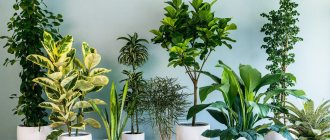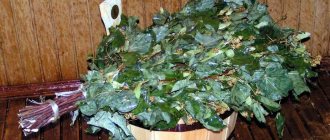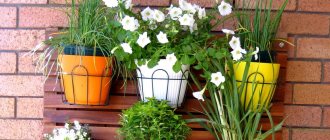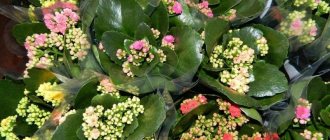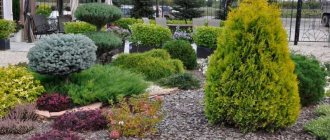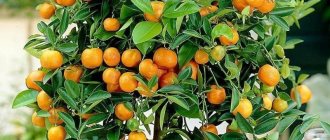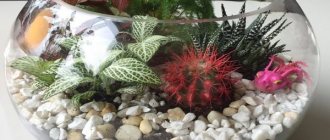Plants that are poisonous and dangerous to humans
Plants that can cause harm to humans belong to the following families:
- Kutrovye are the most harmful house flowers in the world; prominent representatives of the family are: adenium and pachypodium, dipladenia, plumeria, allamanda, strophanthus, carissa. When working with crops, extreme caution should be observed: use rubber gloves, avoid getting poisonous juice on the mucous membrane or skin.
- The aroid family also includes many harmful houseplants: alocasia, aglaonema, monstera, dieffenbachia, philodendron, spathiphyllum, anthurium, syngonium. The toxic effects of individuals are caused by oxalic acid, proteins and enzymes, often used in the manufacture of household chemicals due to their caustic properties.
- Euphorbia flowers (euphorbia, croton, foxtail) contain a poisonous component - euphorin. When the milky juice gets on the skin and mucous membrane, it causes burning, burns and inflammatory processes. You should wash your hands thoroughly after handling the specimen.
Most indoor plants of the Solanaceae family that are harmful to humans (brovallia, brunfelsia, capsicum) are popular among lovers of home floristry. When raising individuals, you should be wary of the internal consumption of poisonous berries of the crop, which cause nausea, vomiting, diarrhea, as well as increased drowsiness and lethargy.
Which house flowers should you be careful with?
Geranium crops captivate with their persistent aroma and bright flowering. Pelargonium leaves contain a high percentage of essential oils that have a beneficial effect on the heart, disinfecting the air, but allergic reactions may occur.
Primrose and calendula affect the mucous membrane, causing acute runny nose, photophobia, poor health, headache, and in more severe cases, asthma attacks.
If you observe an increased threat of poisoning of people and animals, you should remove sources of danger from the apartment.
Rating of poisonous indoor plants
What house flowers cannot be grown at home?
It is not recommended to keep some plants at home for the following reasons:
- They release substances that are harmful to health.
- They can cause allergies, including the appearance of Quincke's edema.
- Poisonous if ingested by fruits, flowers, leaves, stems.
- Poisonous if the juice comes into contact with the skin and mucous membranes.
- They have spines that cause splinters and mechanical damage.
All these reasons encourage a more careful approach to the choice of house plants. Flowers that meet one of these criteria should not be kept at home. Even if there are no allergy sufferers, children or animals in the family, every home has guests from time to time. In order not to overshadow a friend’s visit with a severe attack of allergy to a seemingly harmless flower, it is better to avoid growing dangerous varieties.
Harmful plants for health
Mostly tropical species are harmful. Among indoor flowers, they are the majority: overseas flora attracts gardeners with its bright beauty and rich aromas.
Some of the most popular harmful flowers in cultivation include the following:
- Dieffenbachia;
- Oleander;
- Croton;
- Anthurium;
- Pachistachis.
All these plants have found their niche in floriculture due to the fact that they do not pose a direct danger if they are not touched or ingested. They do not poison the air and do not shoot with spines, but they burn the mucous membranes with juice or poison a person if they enter the blood or stomach.
However, there are also flowers that are familiar to us with rich odors, which can cause serious damage to a person simply due to their aroma. This is, for example, Geranium or Pelargonium. For people who are particularly sensitive to its smell, it is enough to inhale this aroma even at a considerable distance, and an allergic reaction can be very serious.
Flowers with unfavorable signs
As a rule, signs have nothing against the very fact of growing a plant in the house. Harmful flowers can realize their negative potential only if they are located in the wrong place.
For example, you should not place a pot of cactus near the door. This combination will set spouses against each other and lead to constant quarrels in the house.
Folk omens do not recommend bringing some flowers into the house, even in the form of a bouquet. Accordingly, you cannot grow them in your home:
- Callas - they bring sadness to the house.
- Orchids take away vitality, which makes people passive and dull.
- Any climbing plants create obstacles for single women in finding a partner.
- Violets provoke gynecological diseases in the owner, and also interfere with finding love.
Whether to believe signs or not is a personal matter for everyone, but folk wisdom, as a rule, is confirmed over time by scientific research.
Plants dangerous to children
Monstera - why you can’t keep it at home and its effect on humans
Potentially dangerous indoor plants (outsiders) for children include:
- Alocasia. The flower contains a burning poison that causes a burn upon contact with the body and instant blindness in the case of the eyes.
- Dieffenbachia. The juice of a tropical crop, when it comes into contact with the skin, causes irritation; in the case of the eyes and oral cavity, there is a high probability of blindness or swelling of the tongue.
- Cactus. It poses a threat to the child due to its thorns, as well as strong hallucinogens, leading to paralysis of the nervous system during flowering.
- Euphorbia plants are fraught with danger in their poisonous milky juice, which causes stomach problems.
- Cyclamen is accompanied by unpleasant consequences for children who prefer to taste everything. Causes nausea, vomiting, stomach upset and diarrhea.
- Clivia contains poison in the stem and base of the leaves. Poisoning is accompanied by salivation, vomiting and diarrhea. Excessive consumption of the juice of the culture threatens collapse and death.
Note! All indoor flowers carry potential harm to the health of children; the task of parents is to protect children from direct contact with home flora.
Azalea
Beautiful to look at and deadly to taste - this is how this flower can be briefly described. Azalea looks very impressive on any windowsill, has abundant flowering and is easy to care for, but its leaves contain toxic substances. If they enter the digestive tract, they can even cause toxic shock! If you have curious pets in your apartment who are eager to pinch off a leaf or two from the plant, we recommend that you immediately throw the azalea in the trash - this way you will extend the life of your pet for many years.
Folk signs about indoor plants
Flowering is often associated with income, good luck, and pleasant events on the personal front; withering of plants is considered a bad omen. The exception is the Decembrist - premature or late flowering is considered not the best sign.
Male happiness is a flower that cannot be kept at home
The drying of one plant indicates the removal of a strong evil eye, damage, or serious illness. Mass destruction of crops means the presence of negativity in the apartment or serious damage. Disease and wilting of flowers for natural reasons foreshadows purchases.
If in the middle of winter an inflorescence appears, expected in the summer, something pleasant, and to some extent impossible, will happen. The interpretation is determined by the properties of the culture (the flowering of the money tree out of season means unexpected income).
Important! In Islam, it is forbidden to give plants in flowerpots; the gift threatens failure for the giver and the recipient; when receiving the pot, a coin of any denomination must be given in return. This way the gift will turn into a pleasant purchase.
Plants and superstitions
Flowers of separation and loneliness
What indoor flowers can be kept in the bedroom
According to esotericists, the rating of indoor flowers that cannot be kept at home due to a strong energy field that can make the owner unhappy and lonely is topped by:
- Aloe does not tolerate guests in the house.
- Impatiens has gained the status of the flower of widows and brings lack of money.
- The Decembrist is a muzhegon, a companion of separation and loneliness.
- Cacti cause separation, reduce sexual activity, and deprive you of money.
- Monstera makes the owner lonely and has a negative physiological effect, absorbing oxygen at night and depriving sleep.
It is important to know! Climbing plants and vines are the most powerful muzhegons, depriving girls and women of happiness.
What plants should an unmarried woman not have?
Women, especially those who have already been married, know exactly what kind of partner they would like to love. But the problem is that no matter how hard they try, nothing good comes of it. Few realize that it may not be about them, but about the plants that drive away all the profitable suitors.
Florists have compiled a list of flowers that are best kept in the garden:
Chinese rose.
Fern.
Upstart.
Cactus.
Lianas.
Ferns are very treacherous flowers. Although they do not bloom, they are loved for their luxurious green leaves. There is no doubt that this flower is perfect for a garden, cottage, secluded corner in the front garden, or decorating the grave of a beloved relative. But don't put him in an apartment. He draws out all the strength and beauty of a woman. Fern is especially dangerous for those ladies who are over 35. They do not have the opportunity to make a mistake with an unsuitable partner. So throw this plant out of the house if you want to find family happiness.
Upstart, zebrina, vines destroy the beauty of women and make impotent men. Remove these plants from your apartment and life will improve.
interesting and detailed about: Anthurium signs and superstitions. Anthurium good or bad
Rules for keeping plants in the house according to Feng Shui
Using the beneficial energy of indoor plants is a simple and aesthetic way to improve your life. Choosing the right place for a flower helps to achieve a state of harmony in all areas of life.
Feng Shui teachings say:
- Fresh plants in the living room attract wealth and good fortune.
- According to Feng Shui, ideal areas for indoor vegetation in a room are niches and corners.
- In the bedroom, flowerpots are placed near the bed at a distance of 1 m.
- Dry or wilting specimens will spell trouble.
- Prickly varieties do not bring benefits to the apartment; it is advisable to plant the plants in the local area, away from the door.
Feng Shui experts raise the question: why should you avoid bushes and trees grown using bonsai technology? The reason is obvious: artificial growth arrest reduces the flow of positive energy into the house.
Plant shape
Upright crops and vines charge the room with health and vigor; vegetation with hanging stems attracts diseases and fatigue. Thorns and thorns are a sign of aggression and conflict. You should avoid planting individuals with leaves that resemble knives or needles.
Color scheme of cultures and feng shui:
- Orange and red colors awaken the passion and sensuality of a beloved man or woman.
- The pink hue evokes empathy and patience.
- White color stimulates spiritual development.
- The yellow tone evokes negative emotions and feelings.
- Blue inflorescences are a source of creative inspiration.
According to the philosophy of Feng Shui, sources of positive energy are geraniums, begonias, Chinese rose, camellia, the list will be successfully complemented by arrowroot and cyclamen.
The best flowers for the home according to Feng Shui
Interactions with human energy
Based on the interaction of flowers with humans at the energy level, indoor plants are divided into 3 groups:
- Powerful protection (cacti, palms, dracaena, yucca). Holders of strong, pronounced “yang” energy are able to protect the home and make a person active and hardworking. It is advisable to install flowerpots in the hall and office, respectively. Placing crops in the bedroom or children's room will have a negative impact.
- Warmth and care (begonia, camellia, hoya, aloe, azalea). The vegetation of the second group has soft “yin” energy. Cultures improve mood, give confidence, help overcome mental and physiological deficiencies, and improve the atmosphere in an unmarried woman’s apartment.
- Space cleaning (ficus, vines, ivy, hibiscus). Plants of the group eliminate geopathogenic zones, remove energy stagnation and protect against the evil eye.
Interesting fact. At the beginning of the 20th century, scientists proved the ability of plants to transmit information and emit light. It has been experimentally proven that flowers perceive verbal threats and promises. For example, Luther Burbank grew a cactus without thorns, guaranteeing the flower reliable protection. According to research, different individuals have different effects on the aura of a room or person.
What indoor plants should you not keep at home?
The simplest safety rules are to use garden or regular latex gloves when in contact with green residents. If you are pruning or removing branches and foliage, use a special knife. The tools you use in the kitchen should not come into contact with plants. Hands, as well as all cutting or auxiliary objects, should be thoroughly washed upon completion of maintenance work. Remember that individual flowers can actively release toxic substances during irrigation or watering.
Indoor poisonous plants - photos and names
Oleander is very beautiful when in flower, but its aroma can cause dizziness, nausea or even fainting. The juice of leaves and stems can cause allergies or burns to the skin. Do not allow oleander juice to come into contact with your eyes - the consequences can be very dire, including loss of vision.
Oleander, photo:
Potted spurge looks very exotic, thanks to its large, rich green leaves. In fact, the Euphorbiaceae family has many varieties: some resemble cacti, others resemble miniature palms. Some species of milkweed have spines, the pricking of which poses a threat to the body, as they are very poisonous. The foliage and stems of milkweed contain juice, which, if it enters the esophagus, causes severe poisoning, and if it comes into contact with the skin or mucous membranes, leads to burns and irritation.
Euphorbia, photo:
Spurge
Dieffenbachia attracts the eye with its large decorative leaves with a variegated pattern. Its milky juice is very dangerous for the eyes; upon contact with the skin it causes burns, redness, and itching. If it gets into the mouth or esophagus, it causes severe burns of the mucous membranes and poisoning. If you have small children or animals at home, it is better not to get this plant!
Dieffenbachia, photo:
Diefenbachia
Alocasia is an ornamental foliage plant that is very poisonous. Any work with it should be carried out wearing protective gloves, and not only the juice, but even the fumes from the roots are poisonous. On all thematic forums, experienced flower growers strongly recommend using protection when transplanting alocasia. If you disturb the root (for example, cut it), you can smell a distinct cyanide odor, which is not recommended for even long inhalation. If it comes into contact with the eyes, alocasia juice can cause loss of vision, even if a child or animal inadvertently licks a small drop of juice, long-term illness is guaranteed. All parts of alocasia are poisonous: they contain hydrocyanic acid, mercury, and sublimate.
Alocasia, photo:
Alocasia
Croton has very beautiful densely growing leaves; in appearance it resembles a small tree. It blooms very rarely at home, but is often purchased precisely because of its attractive foliage. Croton is also very poisonous; if under some circumstances its juice gets into the blood (through a wound or cut when working with it), then even death is possible. In case of contact with skin, immediately wash the area with soap and water several times.
Croton, photo:
Croton
Azalea is very loved by many gardeners, it is simply luxurious, the flowers have a wide palette of shades, and it is often used to create bonsai. It is poisonous, its foliage contains glycoside and andromedotoxin, which, when ingested by a person or animal, cause poisoning, nausea, and convulsions. The most poisonous is the Sims or Indian Azalea.
Azalea, photo:
Azalea
Evergreen ivy from the Araliaceae family is poisonous in its entirety - the berries, foliage, and stems can be fatal to humans and animals. This vine-like plant is very attractive to cats, and they suffer from it more than others. It also poses a serious danger to people.
Evergreen ivy, photo:
Ivy evergreen
Cyclamen is another house favorite with decorative flowers of unusual shape. Its leaves look very attractive, but are also toxic. Particularly dangerous are cyclamen tubers, which contain a strong poison, similar in strength to the poison of curare. When ingested, it causes a sharp deterioration in health, vomiting, diarrhea, convulsions, and loss of consciousness.
Cyclamen, photo:
Cyclamen
Adenium attracts flower growers with its exotic appearance, which is given to it by thick aerial roots. On top it is decorated with numerous flowers of bright colors and different shapes. Adenium is very poisonous, its juice provokes poisoning and causes burns upon contact with the skin. It should be borne in mind that all its parts contain toxins; this plant is especially harmful for asthmatics. The milky juice of adenium is capable of penetrating into the blood through the skin, so think more than once before bringing it into your home.
Adenium, photo:
Adenium
Monstera can most often be found in offices and public institutions, but flower growers often place it in their homes. It looks very impressive, grows to impressive sizes, and has large carved leaves. Monstera juice is very toxic; if it comes into contact with the skin, it causes a burn and severe itching. If it gets into your eyes, it can significantly damage your vision. If a child or animal eats even a small part of the leaf, poisoning or inflammation of the gastrointestinal tract is inevitable.
Monstera, photo:
Monstera
Brovallia is very attractive, it is not for nothing that its full name is Brovallia the Beautiful. This small bush produces flowers of all shades of blue, lilac, and white. Alas, all parts of Brovallia are poisonous, so its contact with the skin or mucous membranes must be avoided. This flower attracts pets, but its juice is very dangerous for them.
Browallia, photo:
Browallia
Aglaonema amazes with the beauty of its leaves; they are large, dense, with an incredible pattern of diversity. Despite the fact that it has a positive effect on the air in the apartment, cleans and disinfects it, it is still poisonous. The juice is the main danger to people and animals, although the berries are also toxic. If the flower is even slightly damaged (for example, a leaf is broken off or scratched during replanting), the juice will be released immediately. When performing any planting or care work with aglaonema, you should wear protective gloves.
Aglaonema, photo:
Aglaonema
Primrose flowers have a wide range of shades, and the leaves also look cute - round, textured, covered with small fibers. Contact with these villi can cause a severe allergic reaction (burning, itching), and when primrose flowers bloom, dizziness and nausea can occur even in healthy, strong people (it secretes alkaloids). You should know that bright decorative primrose is poisonous, all its parts are toxic and pose a threat to your health.
Primrose, photo:
Primrose
Gloriosa is an exotic, truly luxurious specimen. Its unusual flowers are able to change their shade during flowering. This attractive representative is one of the most toxic among houseplants; all its parts contain poison. If you have children or animals at home, you will have to give up having gloriosa. If it enters the body, it causes severe poisoning, including kidney failure.
Gloriosa, photo:
Gloriosa
Can indoor plants cause allergies? The answer will be positive - yes, they can. Representatives of the family Euphorbiaceae, Solanaceae, Aroidaceae, and Cutroaceae pose a particular threat. You should handle them very carefully and think more than once before bringing them into your home. Kutrovye are the most dangerous; the especially revered adenium, plumeria, carissa, and dipladenia can cause significant harm to the health of your loved ones, as well as pets.
Plumeria, photo:
Plumeria
Dipladenia
Carissa
Remember that even pollen flying in the air can trigger an allergic attack. Almost all domestic flowers emit spores, essential oils, and pollen during flowering, and in particularly toxic varieties, all the released elements will also be by no means useful. Severe allergies can be caused by geranium and fern crops.
Don’t forget about protection if you decide to house one of them. Representatives of the aroid family also require increased attention and isolation from children and pets. Syngonium, a favorite of many, philodendron, contains poisonous components in its juice.
Philodendron
Be careful with euphorbia plants, each of them contains the toxin euphorin, which can cause allergies, skin inflammation, itching, and burns. Wash your hands with soap, use gloves, or better yet, replace them with safer green ones. The world of flowers is diverse and amazing; among the many options, you can always choose a favorite that will not only be safe for health, but also useful.
Is it possible to keep climbing indoor plants at home?
You should not allow plants to climb in your living space - the vines are assigned aggressive masculine energy. Representatives of the stronger half will feel uncomfortable in the space, which is accompanied by a constant desire to leave the room. Ivy and vines suck vitality, optimism and mental health. Keeping plants in the yard, outside the house is beneficial. Cultures look beautiful and protect against the negative emotions of others.
Husbandry plants
Vampire plants
Many types of indoor plants have the ability to absorb negative emotions and protect the health of household members.
Monstera is a “vampire” flower that evokes fear, shock and at the same time feeds on bright positive emotions. The plant is kept in the living room and public spaces where there are a large number of people.
In calm owners, Scindapsus resembles an ordinary vine, also known as epipremnum. For those who like to communicate in raised voices, bindweed will grow into a lush jungle.
Chlorophytum neutralizes negative emotions caused by problems at work, financial difficulties and fatigue after shopping or watching videos. It is also useful for children, after talking with their peers, to spend half an hour on the plant: moisten, loosen, cut off old leaves. Variegated chlorophytum is recommended for older people; the individual takes away negative energy, providing a calming effect.
Important! Ferns are successfully used in rooms with the maximum release of energy: offices, theater foyers, home living rooms with a TV. The plant feels comfortable in diffused light, near a source of energy surge (TV, large household appliances, active employees).
Orchids make a huge contribution to heated disputes, passions, and console those who cry. Seeing the exquisite flowering, people involuntarily think about the beauty of the world, about spirituality, and harmony.
Sheflera is useful for schoolchildren and students immersed in mental and creative work. Culture promotes collaboration, inspiration and learning.
Asparagus absorbs the energetic manifestation of weakness, lack of will, and laziness. Suitable for people involved in business, creativity and sports.
Sansevieria feeds on strong electromagnetic radiation generated by household or office equipment and does not respond to subtle energies; one should not expect a calming effect from the plant.
Beware, vampire flowers
Many plants are poisonous and dangerous, but most are successfully cultivated by people. It may be worth avoiding buying a flower that could harm your household. However, when deciding to grow potentially hazardous crops, every effort should be made to reduce the risk. Children and animals (cats, dogs) should not be allowed to come into contact with the crop, place beds nearby, and rubber gloves should be used when working with the specimen. Following simple rules will reduce the threat and allow you to enjoy the natural beauty of plants.
10 “unlucky” flowers that should not be kept in the house
House plants and flowers can have negative energy or even be vampires. This is why it is not recommended to keep some flowers in the house.
Of course, the energy in the house should be positive. After all, it is she who attracts good luck to all its residents. Previously, we wrote about which plants bring happiness to the house. This article will help you find the perfect energy companion for you. And today we will talk about which flowers should not be kept at home at all.
10 unlucky flowers
Rose. At first glance, this is a beautiful flower that is the king of all flowers. However, the rose is not only beautiful. She perfectly absorbs energy, thus being not a donor, but a vampire. At the same time, the rose gives almost nothing in return, so it is advisable to keep roses at home only for those who are sure that they have something to give.
Orchid. With just its name, this flower can win your love, but don’t be naive. They say that the orchid takes energy by feeding on the shortcomings of people. This is a pure vampire who has no limitations. The orchid rarely takes root in homes, but if this happens, then those who have problems with self-confidence will be even more unhappy. The flower also provokes insomnia. If you are ready to have an orchid against all odds, do not place it next to your sleeping place.
Begonias . These flowers are known for their popularity, but they can easily steal energy from people. True, they attract both positive and negative energy, which can partly serve as a good service. Moreover, when a plant shares what it has taken, it keeps the negative for itself, giving a small part of the positive back. But you should not keep more than one such flower at home, so as not to disrupt energy exchange.
Lilies. These seemingly harmless flowers can provoke scandals. They are dangerous because of their unexpectedness, since they can give peace and order to the home for a long time, and then suddenly change their energy. Keep lilies where you don't visit often - for example, in the country.
Lilac. Every person experiences pleasure when passing by a lilac bush in the summer. You should not cut these flowers home: many folk signs say that lilacs only bring trouble. Previously, we wrote about the magical properties of lilac and the signs associated with it. This article will help you not only learn more about lilacs, but also do the right thing when they bloom.
Tulips. There is a sign that these flowers provoke hair loss, deterioration of skin condition and increase nervousness. Of course, many people love tulips, and you shouldn’t give them up completely. Just don’t plant them close to the house, for example, under the windows of a summer house.
Ferns. These flowers are good in front gardens and garden plots. They can beautifully decorate a flower garden, you can decorate a fern with flowers for Ivan Kupala. But experts do not recommend keeping it at home: it absorbs oxygen, releasing carbon dioxide, which means it can give you headaches.
Tuberose. This flower smells very tasty, it is even used in perfumery, but this advantage cannot be compared with its disadvantage. He provokes betrayal. If you are married and do not want problems, it is better to give up this flower once and for all.
Hippeastrum. This representative of the world of flora really does not like it when someone makes a scandal in his presence, pouring out negativity. This flower takes everything to the last drop, giving it back later. If someone often quarrels at home, you risk never getting rid of the constant influx of negative energy.
Oleander . In some cases, the smell of this incredibly beautiful flower can cause dizziness. If you have small children at home, then under no circumstances buy oleander as decoration.
Stellera dwarf . This Japanese flower poses one great danger to small children and animals. The sap of the plant can cause health problems, which can be very dangerous for children.
Remember that many plants and flowers cannot be kept in the bedroom. This is the most important recommendation from the sages of Feng Shui. The bedroom should be neutral in its energy and not carry any negativity. Previously, we wrote about which indoor flowers according to Feng Shui will be the most useful.
